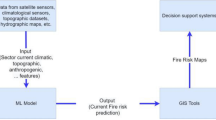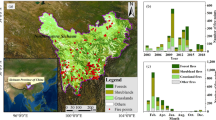Abstract
Fires, including wildfires, harm air quality and essential public services like transportation, communication, and utilities. These fires can also influence atmospheric conditions, including temperature and aerosols, potentially affecting severe convective storms. Here, we investigate the remote impacts of fires in the western United States (WUS) on the occurrence of large hail (size: ⩾ 2.54 cm) in the central US (CUS) over the 20-year period of 2001–20 using the machine learning (ML), Random Forest (RF), and Extreme Gradient Boosting (XGB) methods. The developed RF and XGB models demonstrate high accuracy (> 90%) and F1 scores of up to 0.78 in predicting large hail occurrences when WUS fires and CUS hailstorms coincide, particularly in four states (Wyoming, South Dakota, Nebraska, and Kansas). The key contributing variables identified from both ML models include the meteorological variables in the fire region (temperature and moisture), the westerly wind over the plume transport path, and the fire features (i.e., the maximum fire power and burned area). The results confirm a linkage between WUS fires and severe weather in the CUS, corroborating the findings of our previous modeling study conducted on case simulations with a detailed physics model.
Similar content being viewed by others
References
Abatzoglou, J. T., and C. A. Kolden, 2013: Relationships between climate and macroscale area burned in the western United States. International Journal of Wildland Fire, 22(7), 1003–1020, https://doi.org/10.1071/WF13019.
Blair, S. F., D. R. Deroche, J. M. Boustead, J. W. Leighton, B. L. Barjenbruch, and W. P. Gargan, 2011: A radar-based assessment of the detectability of giant hail. E-Journal of Severe Storms Meteorology, 6(7), https://doi.org/10.55599/ejssm.v6i7.34.
Blair, S. F., and Coauthors, 2017: High-resolution hail observations: Implications for NWS warning operations. Weather and Forecasting, 32(3), 1101–1119, https://doi.org/10.1175/WAF-D-16-0203.1.
Boulesteix, A.-L., S. Janitza, J. Kruppa, and I. R. König, 2012: Overview of random forest methodology and practical guidance with emphasis on computational biology and bioinformatics. WIREs Data Mining and Knowledge Discovery, 2(6), 493–507, https://doi.org/10.1002/widm.1072.
Breiman, L., 2001: Random forests. Machine Learning, 45(1), 5–32, https://doi.org/10.1023/A:1010933404324.
Chen, T. Q., and C. Guestrin, 2016: XGBoost: A scalable tree boosting system. Proc. 22nd ACM SIGKDD International Conference on Knowledge Discovery and Data Mining, San Francisco, California, USA, ACM, https://doi.org/10.1145/2939672.2939785.
Cunningham, P., and M. J. Reeder, 2009: Severe convective storms initiated by intense wildfires: Numerical simulations of pyro-convection and pyro-tornadogenesis. Geophys. Res. Lett., 36(12), L12812, https://doi.org/10.1029/2009GL039262.
Dennis, E. J., and M. R. Kumjian, 2017: The impact of vertical wind shear on hail growth in simulated supercells. J. Atmos. Sci., 74(3), 641–663, https://doi.org/10.1175/JAS-D-16-0066.1.
Dennison, P. E., S. C. Brewer, J. D. Arnold, and M. A. Moritz, 2014. Large wildfire trends in the western United States, 1984–2011. Geophys. Res. Lett., 41(8), 2928–2933, https://doi.org/10.1002/2014GL059576.
Fromm, M., A. Tupper, D. Rosenfeld, R. Servranckx, and R. McRae, 2006: Violent pyro-convective storm devastates Australia’s capital and pollutes the stratosphere. Geophys. Res. Lett., 33(5), L05815, https://doi.org/10.1029/2005GL025161.
Gelaro, R., and Coauthors, 2017: The Modern-Era Retrospective Analysis for Research and Applications, Version 2 (MERRA-2). J. Climate, 30, 5419–5454, https://doi.org/10.1175/JCLI-D-16-0758.1.
Grell, G., S. R. Freitas, M. Stuefer, and J. Fast, 2011: Inclusion of biomass burning in WRF-Chem: Impact of wildfires on weather forecasts. Atmospheric Chemistry and Physics, 11(11), 5289–5303, https://doi.org/10.5194/acp-11-5289-2011.
Huang, X., M. Li, J. Li, and Y. Song, 2012: A high-resolution emission inventory of crop burning in fields in China based on MODIS thermal anomalies/fire products. Atmosphericenvironment, 50, 9–15, https://doi.org/10.1016/j.atmosenv.2012.01.017.
Jacobo, J., and G. Zee, 2021: Climate change may be causing an early start to fire season in the West. Retrieved from https://abcnews.go.com/US/climate-change-causing-early-start-fire-season-west/story?id=77737065.
Jain, P., X. Wang, and M. D. Flannigan, 2017: Trend analysis of fire season length and extreme fire weather in North America between 1979 and 2015. International Journal of Wildland Fire, 26(12), 1009–1020, https://doi.org/10.1071/WF17008.
Janzing, D., L. Minorics, and P. Blöbaum, 2019: Feature relevance quantification in explainable AI: A causal problem. arXiv preprint arXiv: 1910.13413, https://doi.org/10.48550/arXiv.1910.13413.
Jeong, J.-H., J. W. Fan, C. R. Homeyer, and Z. S. Hou, 2020: Understanding hailstone temporal variability and contributing factors over the U.S. southern great plains. J. Climate, 33(10), 3947–3966, https://doi.org/10.1175/Jcli-D-19-0606.1.
Jeong, J.-H., J. W. Fan, and C. R. Homeyer, 2021: Spatial and temporal trends and variabilities of hailstones in the United States Northern Great Plains and their possible attributions. J. Climate, 34(16), 6819–6840, https://doi.org/10.1175/Jcli-D-20-0245.1.
Jolly, W. M., M. A. Cochrane, P. H. Freeborn, Z. A. Holden, T. J. Brown, G. J. Williamson, and D. M. Bowman, 2015: Climate-induced variations in global wildfire danger from 1979 to 2013. Nature Communications, 6(1), 7537, https://doi.org/10.1038/ncomms8537.
Kablick III, G., and Coauthors, 2018: The great slave lake PyroCb of 5 August 2014: Observations, simulations, comparisons with regular convection, and impact on UTLS water vapor. J. Geophys. Res., 123(21), 12332–12352, https://doi.org/10.1029/2018JD028965.
Lee, H., S.-J. Jeong, O. Kalashnikova, M. Tosca, S.-W. Kim, and J.-S. Kug, 2018: Characterization of wildfire - induced aerosol emissions from the Maritime Continent peatland and Central African dry savannah with MISR and CALIPSO aerosol products. J. Geophys. Res., 123(6), 3116–3125, https://doi.org/10.1002/2017JD027415.
Lee, H.-H., and C. Wang, 2020: The impacts of biomass burning activities on convective systems over the Maritime Continent. Atmospheric Chemistry and Physics, 20(4), 2533–2548, https://doi.org/10.5194/acp-20-2533-2020.
Lindsey, D. T., and Fromm, M., 2008: Evidence of the cloud lifetime effect from wildfire - induced thunderstorms. Geophys. Res. Lett., 35(22), L22809, https://doi.org/10.1029/2008GL035680.
Liu, X. X., and Coauthors, 2017: Airborne measurements of western U.S. wildfire emissions: Comparison with prescribed burning and air quality implications. J. Geophys. Res., 122(11), 6108–6129, https://doi.org/10.1002/2016JD026315.
Liu, Y. Q., S. L. Goodrick, and J. A. Stanturf, 2013: Future U.S. wildfire potential trends projected using a dynamically down-scaled climate change scenario. Forest Ecology and Management, 294, 120–135, https://doi.org/10.1016/j.foreco.2012.06.049.
Logan, T., X. Q. Dong, and B. K. Xi, 2018: Aerosol properties and their impacts on surface CCN at the ARM Southern Great Plains site during the 2011 Midlatitude Continental Convective Clouds Experiment. Adv. Atmos. Sci., 35(2), 224–233, https://doi.org/10.1007/s00376-017-7033-2.
Lu, Z., and I. N. Sokolik, 2013: The effect of smoke emission amount on changes in cloud properties and precipitation: A case study of Canadian boreal wildfires of 2007. J. Geophys. Res., 118(20), 11777–11793, https://doi.org/10.1002/2013JD019860.
Lundberg, S. M., and S.-I. Lee, 2017: A unified approach to interpreting model predictions. Proc. 31st International Conference on Neural Information Processing Systems, Long Beach, California, USA, Curran Associates Inc., 4768–4777.
Lundberg, S. M., and Coauthors, 2020: From local explanations to global understanding with explainable AI for trees. Nature Machine Intelligence, 2(1), 56–67, https://doi.org/10.1038/s42256-019-0138-9.
Mueller, S. E., A. E. Thode, E. Q. Margolis, L. L. Yocom, J. D. Young, and J. M. Iniguez, 2020: Climate relationships with increasing wildfire in the southwestern US from 1984 to 2015. Forest Ecology and Management, 460, 117861, https://doi.org/10.1016/j.foreco.2019.117861.
Nohara, Y., K. Matsumoto, H. Soejima, and N. Nakashima, 2019: Explanation of machine learning models using improved Shapley Additive Explanation. Proc. 10th ACM International Conference on Bioinformatics, Computational Biology and Health Informatics, Niagara Falls, NY, USA, ACM, https://doi.org/10.1145/3307339.3343255.
Trentmann, J., and Coauthors, 2006: Modeling of biomass smoke injection into the lower stratosphere by a large forest fire (Part I): Reference simulation. Atmospheric Chemistry and Physics, 6(12), 5247–5260, https://doi.org/10.5194/acp-6-5247-2006.
Wang, S. S.-C., and Y. Wang, 2020: Quantifying the effects of environmental factors on wildfire burned area in the south central US using integrated machine learning techniques. Atmospheric Chemistry and Physics, 20(18), 11065–11087, https://doi.org/10.5194/acp-20-11065-2020.
Westerling, A. L., H. G. Hidalgo, D. R. Cayan, and T. W. Swetnam, 2006: Warming and earlier spring increase western US forest wildfire activity. Science, 313(5789), 940–943, https://doi.org/10.1126/science.112883.
Zhang, Y. W., J. W. Fan, T. Logan, Z. Q. Li, and C. R. Homeyer, 2019: Wildfire impact on environmental thermodynamics and severe convective storms. Geophys. Res. Lett., 46(16), 10082–10093, https://doi.org/10.1029/2019GL084534.
Zhang, Y. W., J. W. Fan, M. Shrivastava, C. R. Homeyer, Y. Wang, and J. H. Seinfeld, 2022: Notable impact of wildfires in the western United States on weather hazards in the central United States. Proceedings of the National Academy of Sciences of the United States of Amecica, 119(44), e2207329119, https://doi.org/10.1073/pnas.2207329119.
Acknowledgements
This paper is based upon work supported by the U.S. Department of Energy, Office of Science, Office of Biological and Environmental Research program as part of the Regional and Global Model Analysis and Multi-Sector Dynamics program areas (Award Number DE-SC0016605). Argonne National Laboratory is operated for the DOE by UChicago Argonne, LLC, under contract DE-AC02-06CH11357. This research used resources of the National Energy Research Scientific Computing Center (NERSC). NERSC is a U.S. DOE Office of Science User Facility operated under Contract DE-AC02-05CH11231.
Author information
Authors and Affiliations
Contributions
Author contributions Xinming LIN conducted the technical work. Jiwen FAN conceived the idea. Jiwen FAN and Z. Jason HOU guided the research. Yuwei ZHANG provided comments on technical details. All authors contributed to the writing of the manuscript.
Corresponding author
Additional information
Article Highlights
• RF and XGB models are developed to establish connections between WUS fires and large hail occurrence in the CUS.
• The built ML models can make accurate predictions for large hail occurrence in several central US states.
• Meteorology and fire features in the western fire region are identified as important variables contributing to accurate prediction.
This paper is a contribution to the special issue on AI Applications in Atmospheric and Oceanic Science: Pioneering the Future.
Rights and permissions
About this article
Cite this article
Lin, X., Fan, J., Zhang, Y. et al. Machine Learning Analysis of Impact of Western US Fires on Central US Hailstorms. Adv. Atmos. Sci. (2024). https://doi.org/10.1007/s00376-024-3198-7
Received:
Revised:
Accepted:
Published:
DOI: https://doi.org/10.1007/s00376-024-3198-7




